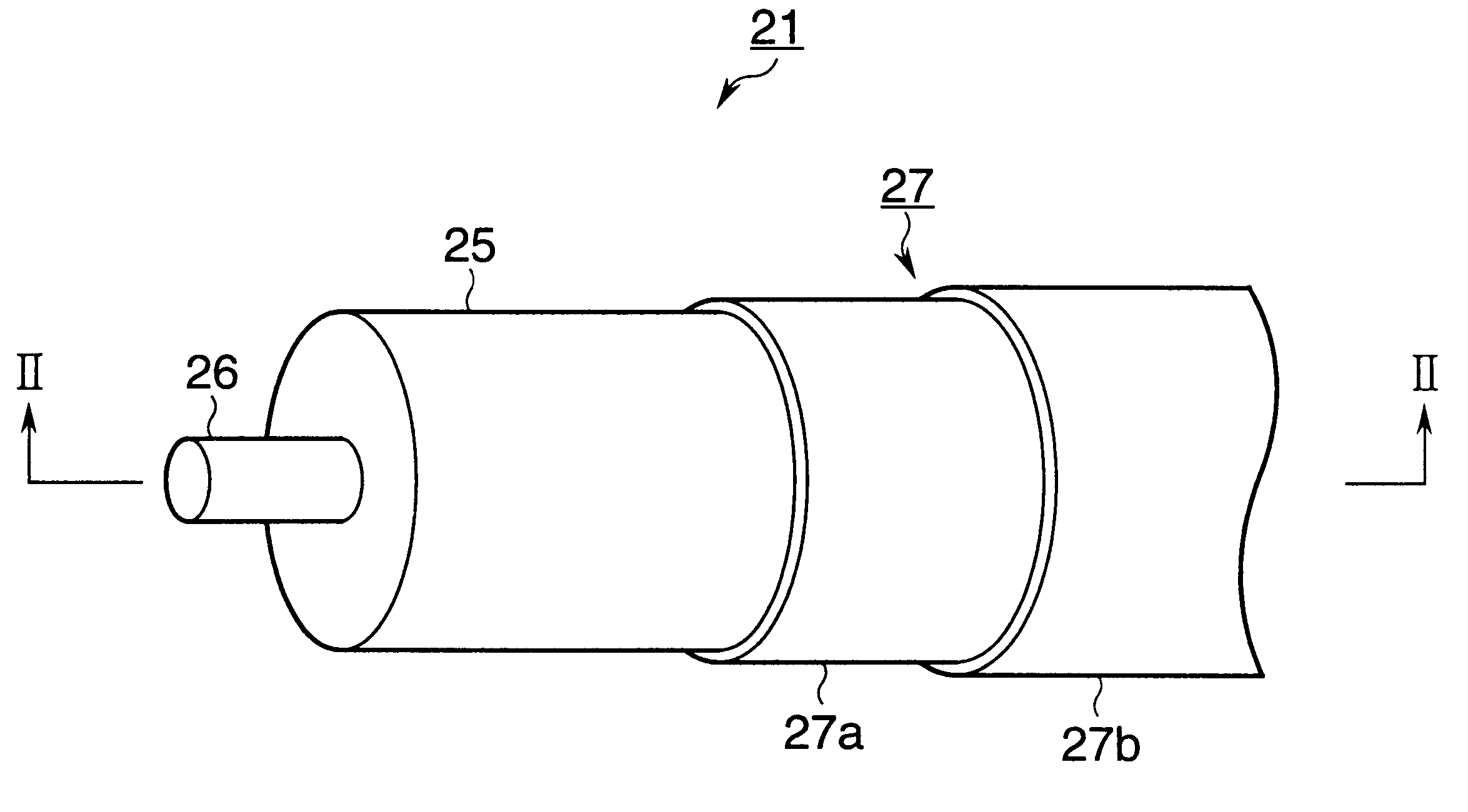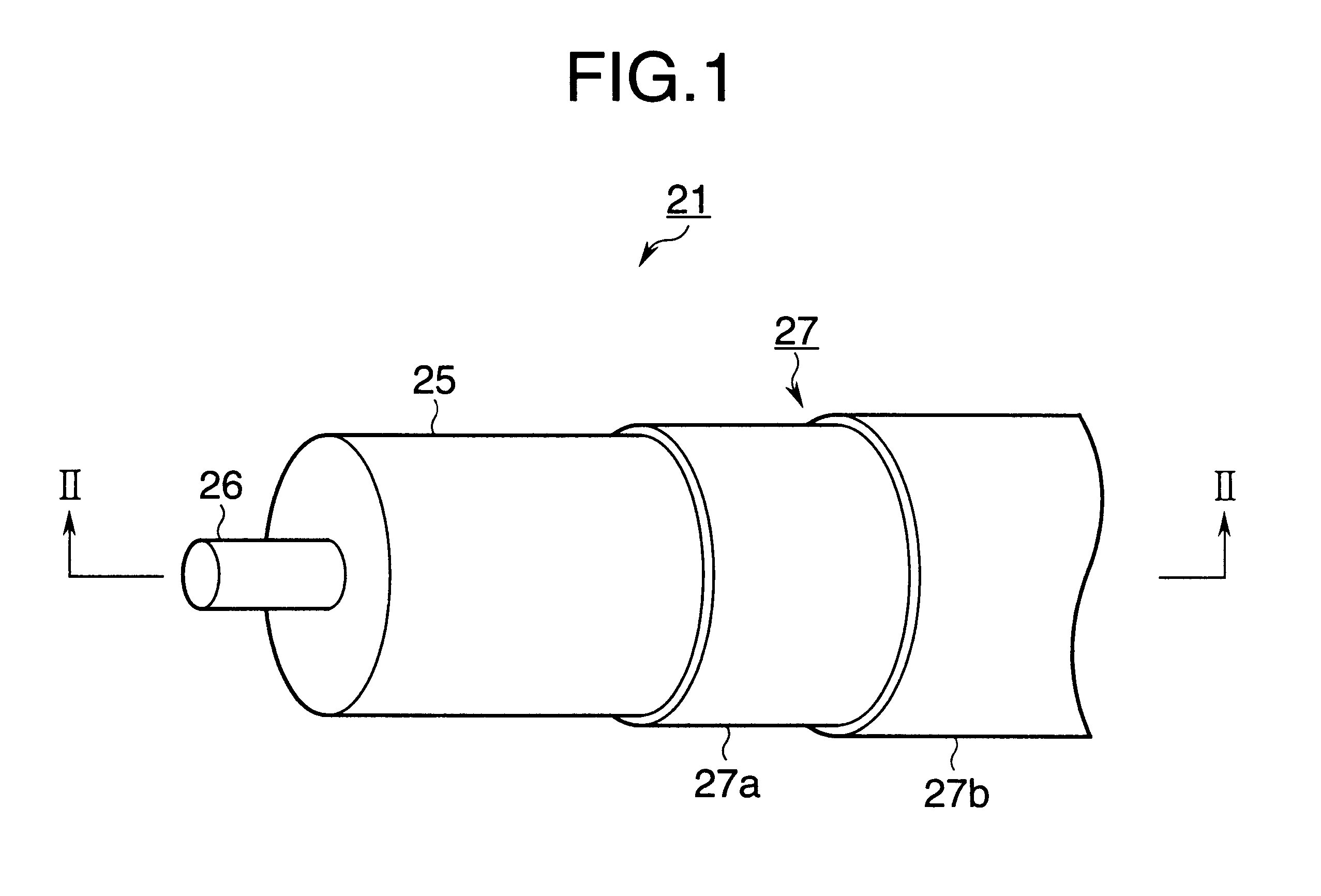Transfer roller
- Summary
- Abstract
- Description
- Claims
- Application Information
AI Technical Summary
Benefits of technology
Problems solved by technology
Method used
Image
Examples
first embodiment
FIG. 1 is a fragmentary perspective view of a transfer roller according to a first embodiment.
FIG. 2 is a longitudinal cross-sectional view taken along lines II--II of FIG. 1.
FIGS. 3 and 4 show characteristics of a resin tube 27 of FIG. 1.
FIG. 3 plots the voltage applied to a transfer roller 21 as abscissa and the resistance of the resin tube 27 as ordinate.
FIG. 4 plots the time for which the transfer voltage is applied to the transfer roller 21 as abscissa and the resistance of the resin tube 27 as ordinate.
In FIGS. 3 and 4, the solid lines indicate the characteristics of the transfer roller 21 when carbon black is added as an electrically conductive material and the dotted lines represent the characteristics of the transfer roller 21 when an organic ion electrically conductive material is added.
Referring to FIGS. 1 and 2, the transfer roller 21 includes a metal shaft 26, a sponge-like electrically semiconductive rubber roller 25 formed around the shaft 26, and an electrically semi...
second embodiment
Elements of the same construction as those of the first embodiment have been given the same reference numerals.
FIG. 5 is a longitudinal cross-sectional view of a transfer roller according to a second embodiment.
FIG. 6 is an enlarged fragmentary view of the transfer roller of FIG. 5.
Referring to FIGS. 5 and 6, a semiconductive resin tube 37 is formed on the rubber roller 25. The resin tube 37 is of a dual-layer structure having a lower layer 37a formed directly on the rubber roller 25 and an upper layer 37b formed on the lower layer 37a. The resin tube 37 is slightly longer than the rubber roller 25. When the resin tube 37 formed on the rubber roller 25 is subjected to heat shrinkage, the resin tube 37 extending beyond the longitudinal ends of the rubber roller 25 shrinks to wrap around the longitudinal end corners of the rubber roller 25, leaving a round portion m (FIG. 6) around the longitudinal end corners of the rubber roller 25.
When the transfer roller 31 receives a transfer vol...
example
The rubber roller 25 is in the form of an electrically semiconductive sponge and the resin tube 27 has a resistance of about 10.sup.8 .OMEGA.. The thickness of the resin tube 27 is about 100 .mu.m. The lower layer 27a has a thickness of about 20 .mu.m and the upper layer 27b has a thickness of about 80 .mu.m. The resistance of the lower layer 27a is about ten times as high as that of the upper layer 27b. The resin tube 27 has substantially the same total resistance as the rubber roller 25. Thus, the total resistance of the transfer roller 21 is substantially the same before and after the resin tuber 27 is formed over the rubber roller 25.
If only carbon black as an electrically conductive material is added to the resin tube 27, the electrical resistance increases with increasing the accumulated time of application of high voltage, causing changes in the overall resistance of the transfer roller. Therefore, it is necessary to make the resistance of the resin tube 27 as stable as possi...
PUM
 Login to View More
Login to View More Abstract
Description
Claims
Application Information
 Login to View More
Login to View More - R&D
- Intellectual Property
- Life Sciences
- Materials
- Tech Scout
- Unparalleled Data Quality
- Higher Quality Content
- 60% Fewer Hallucinations
Browse by: Latest US Patents, China's latest patents, Technical Efficacy Thesaurus, Application Domain, Technology Topic, Popular Technical Reports.
© 2025 PatSnap. All rights reserved.Legal|Privacy policy|Modern Slavery Act Transparency Statement|Sitemap|About US| Contact US: help@patsnap.com



